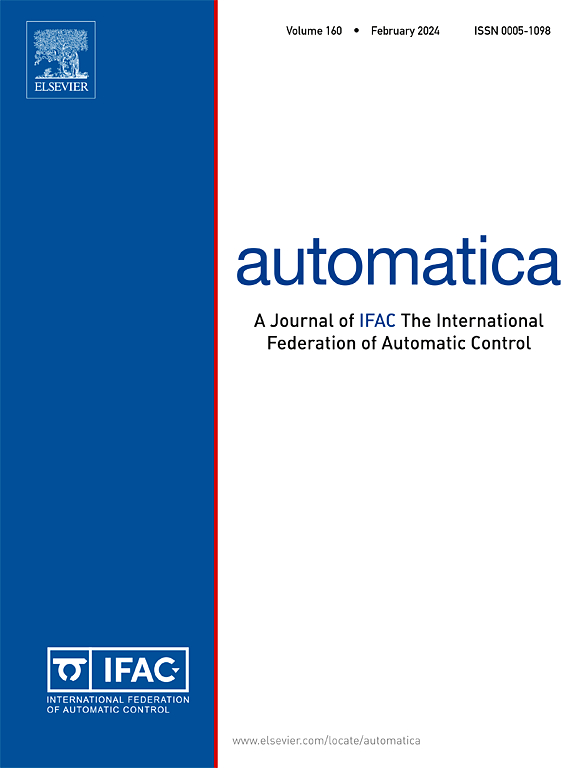Revisiting Lossless Convexification: Theoretical guarantees for discrete-time optimal control problems
IF 5.9
2区 计算机科学
Q1 AUTOMATION & CONTROL SYSTEMS
引用次数: 0
Abstract
Lossless Convexification (LCvx) is a modeling approach that transforms a class of nonconvex optimal control problems, where nonconvexity primarily arises from control constraints, into convex problems through convex relaxations. These convex problems can be solved using polynomial-time numerical methods after discretization, which converts the original infinite-dimensional problem into a finite-dimensional one. However, existing LCvx theory is limited to continuous-time optimal control problems, as the equivalence between the relaxed convex problem and the original nonconvex problem holds only in continuous-time. This paper extends LCvx theory to discrete-time optimal control problems by classifying them into normal and long-horizon cases. For normal cases, after an arbitrarily small perturbation to the system dynamics (recursive equality constraints), applying the existing LCvx method to discrete-time problems results in optimal controls that meet the original nonconvex constraints at all but no more than temporal grid points, where is the state dimension. For long-horizon cases, the existing LCvx method fails, but we resolve this issue by integrating it with a bisection search, leveraging the continuity of the value function from the relaxed convex problem to achieve similar results as in normal cases. This paper strengthens the theoretical foundation of LCvx, extending the applicability of LCvx theory to discrete-time optimal control problems.
再论无损凸化:离散时间最优控制问题的理论保证
无损凸化(LCvx)是一种将一类非凸最优控制问题(其中非凸性主要来自控制约束)通过凸松弛转化为凸问题的建模方法。这些凸问题经过离散化处理后,可以用多项式时间数值方法求解,将原来的无限维问题转化为有限维问题。然而,现有的LCvx理论仅限于连续时间最优控制问题,松弛凸问题与原非凸问题之间的等价性仅在连续时间中存在。本文将lcv理论推广到离散时间最优控制问题,将其分为正常情况和长视界情况。通常情况下,在对系统动力学(递归等式约束)进行任意小的扰动后,将现有的LCvx方法应用于离散时间问题会得到满足原始非凸约束的最优控制,但不超过nx−1个时间网格点,其中nx是状态维。对于长视界情况,现有的LCvx方法失败了,但我们通过将其与二分搜索相结合来解决这个问题,利用松弛凸问题的值函数的连续性来获得与正常情况相似的结果。本文加强了LCvx的理论基础,扩展了LCvx理论在离散时间最优控制问题中的适用性。
本文章由计算机程序翻译,如有差异,请以英文原文为准。
求助全文
约1分钟内获得全文
求助全文
来源期刊

Automatica
工程技术-工程:电子与电气
CiteScore
10.70
自引率
7.80%
发文量
617
审稿时长
5 months
期刊介绍:
Automatica is a leading archival publication in the field of systems and control. The field encompasses today a broad set of areas and topics, and is thriving not only within itself but also in terms of its impact on other fields, such as communications, computers, biology, energy and economics. Since its inception in 1963, Automatica has kept abreast with the evolution of the field over the years, and has emerged as a leading publication driving the trends in the field.
After being founded in 1963, Automatica became a journal of the International Federation of Automatic Control (IFAC) in 1969. It features a characteristic blend of theoretical and applied papers of archival, lasting value, reporting cutting edge research results by authors across the globe. It features articles in distinct categories, including regular, brief and survey papers, technical communiqués, correspondence items, as well as reviews on published books of interest to the readership. It occasionally publishes special issues on emerging new topics or established mature topics of interest to a broad audience.
Automatica solicits original high-quality contributions in all the categories listed above, and in all areas of systems and control interpreted in a broad sense and evolving constantly. They may be submitted directly to a subject editor or to the Editor-in-Chief if not sure about the subject area. Editorial procedures in place assure careful, fair, and prompt handling of all submitted articles. Accepted papers appear in the journal in the shortest time feasible given production time constraints.
 求助内容:
求助内容: 应助结果提醒方式:
应助结果提醒方式:


